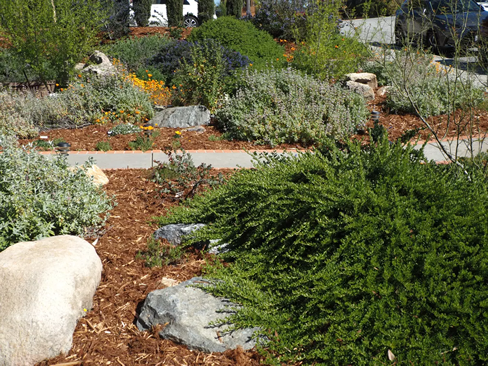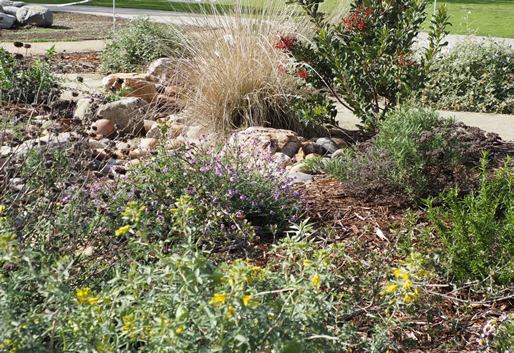California native plants a waterwise option right under our noses

Planting 75 percent of your landscape with evergreen perennials and seasonal blooming plants for the last 25 percent will keep visual interest year-round. (Lucy Warren)
California native plants a waterwise option right under our noses
(This article originally appeared in the San Diego Union-Tribune September 9, 2023)
As gardeners, we are drawn to the latest, brightest varieties of thirsty, exotic species for our gardens, always chasing the new and unusual. As our world heats up with climate change, water-thirsty lawns are being sacrificed for moonscapes of rocks and cactus, or spiky, heat-intensive green plastic “lawns.” Neither of these alternatives are eco-friendly.
Our native plants are special! There are so many to choose from. We live in one of the driest of the world’s five Mediterranean climates. California’s complex geology has created a multitude of different soil profiles. The California floristic province has about 2,600 endemic species found nowhere else on earth. San Diego County has the most diversity of native species in California.
With so many California native plants, you can design beyond typical xeriscape: formal to casual, desert to woodland, even Japanese-style. When recently asked whether an English cottage-style garden could be created with California natives, the list of potential plants was astounding.
Many people ask if they can mix natives and exotic plants in their gardens. The answer is “yes, but why?” Because natives require different kinds of care, especially those with different water requirements, why would you? If you like natives and other species, plant them in different parts of your garden. Keep the natives together, just like you do your vegetables.
The plants that evolved in our unique and challenging environment through the eons are tough IF they are tended according to their needs. Most failures of California native landscapes result from utilizing traditional horticultural methods, such as overwatering and overfeeding.
The secret to creating a native landscape with year-round beauty is to plant it with three-quarters evergreen perennial plants, trees and shrubs. Then tuck in the seasonal blooming plants where their foliage will die back or you can reach them to deadhead.
Think to the future as you plan your native garden. That small shrub in a 1-gallon pot can grow to an enormous size, so read the label and create enough space for it to reach maturity. You will save money and a great deal of future work. It is amazing how quickly 1-gallon and 5-gallon plants will grow in your garden.
Some things to remember as you plan your garden: Prepare the site. Remove old plant material and turf to bare native soil. Forget about fertilizer and supplements; instead, use those on your houseplants and vegetables.
The best type of irrigation system is one that mimics nature. Micro-spray heads wash off the leaves of the plant without saturating the soil during the summer, when the plants don’t expect a drenching. You can also hand water and keep in touch with your plants. If you want to keep your natives alive for the long haul, it is best to avoid single drip emitters.

Evergreen color and texture in a California native landscape. (Lucy Warren)
Spend the money you have saved in buying smaller plants on good mulch. A 4-inch layer of shredded redwood bark replicates native duff and lasts for years. Wood chips degrade more quickly. Desert and coast plants are the exceptions, as they like inorganic mulch, sand and pebbles.
Plant your plants in the ground at the same level as the soil line in the pot. Do not dig the hole any deeper, but dig to double the width of the pot. Remove the plant from the pot and pop it in the ground. Then fill in the soil around the edges. If your hole is too deep, fill it in and dig a shallower one beside it.
As soon as you have planted your natives, water, water, water! That very same day, hopefully, that very same hour. It is the most water you will ever use. It provides moisture for the plant and, importantly, settles the soil around the roots. Natives do not like air on their roots.
Watch the young plants; they will need more frequent watering as they settle into their new home.
Also, pay close attention to ants. The exotic Argentine ants that have invaded California have no natural predators. They will place scale and aphids on the roots of California natives, which will suck the life out of the plants. Typical ant baits will kill the worker ants and leave the queen to pump out more. So, you will need to treat with low-dose baits that workers will take back to the nest to kill the queen.
Enjoy your native landscape! The green space around your home will help to cool the earth. The plants will attract and help to maintain species of rare and endangered fauna. Children love to play in a diverse landscape. And you will be the envy of your lawn-addicted neighbors with more time to enjoy it.
Warren, a Master Gardener since 1994, is a garden writer and co-author of “The Drought-Defying California Garden: 250 Native Plants For a Lush Low-Water Landscape” with Greg Rubin.

